6 The Taylor Family of Winsley, Wiltshire
In the rest of this book I will follow the ancestry of Robert Francis Nurse’s mother Ann Jane Taylor, my great great grandmother, starting with the Taylor line itself, which I have been able to trace successfully back to about 1700.
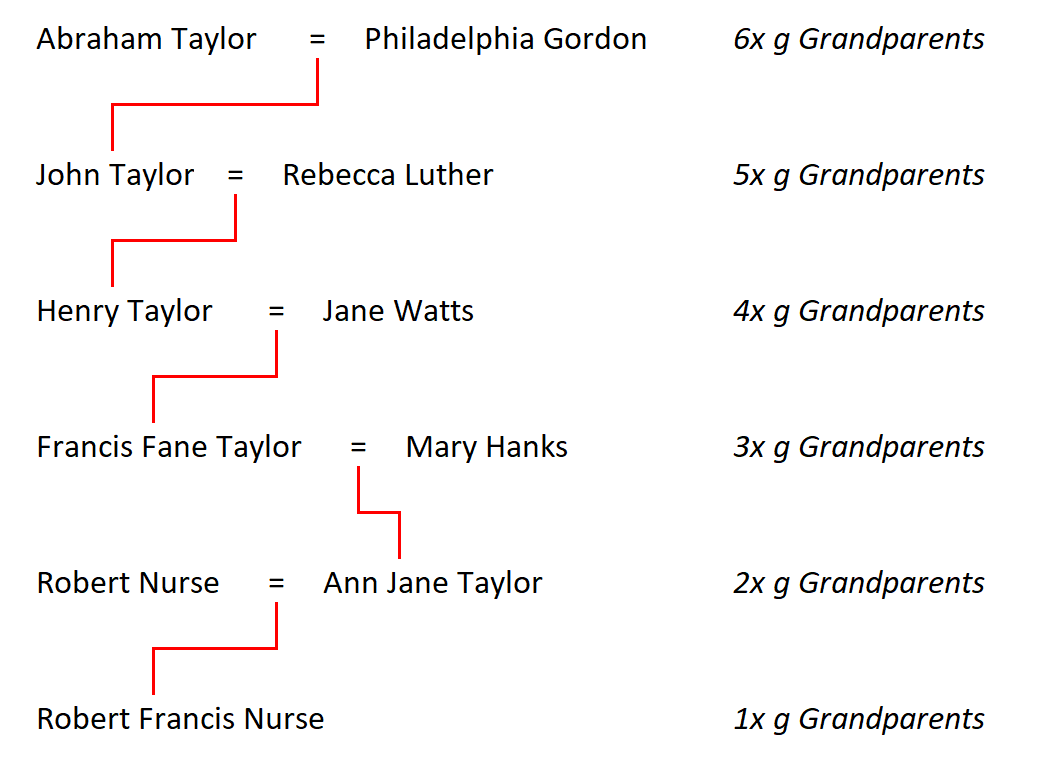
My Taylor Ancestors were the link to the Landed Gentry of England and eventually to the English Nobility and Royalty through two important women.
The first is Rebecca Luther, my 5x great grandmother, who married the Landscape Painter John Taylor of Bath (see Section 6.3). It is through Rebecca’s paternal grandmother that I am related to Sir Thomas More, Henry VIII’s Chancellor who was made famous in the play - A Man for All Seasons.
In addition through Rebecca’s mother, I am related to the Chamberlain family, who were famous for inventing the birthing forceps and the Paxton family, famous for the letters they wrote in the time of The War of the Roses.
The second is John Taylor’s mother Philadelphia Gordon, my 6x great grandmother. She was the daughter of Patrick Gordon, Lieutenant Governor of Pennsylvania during Colonial times, and who was from a cadet branch of Clan Gordon in Scotland.
I have proven that both women were descended from English Royalty, Rebecca from Edward I and Philadelphia from Edward III. In addition, Philadelphia is descended from Scottish Royalty as a descended of James I of Scotland.
So as with the previous chapters of the book I will start with Francis Fane Taylor, Ann’s father.
6.1 Francis Fane Taylor of Winsley, (Born 1802)
3rd Great Grandfather – FFFMF1
Francis Fane Taylor was born in Farley, Wiltshire - just to the east of Salisbury - to Henry and Jane Taylor.2

Francis’s parents moved quite a lot during the early 1800s but by the time Francis was grown up the family had moved to Bearfield, in Bradford on Avon, where his father was a Farmer3. Francis married Mary Hanks, by license, at St. Nicholas, Winsley on 1 Sept 18254. Francis was a carpenter, and Francis and Mary lived at “Bleak House” in Winsley Village, where the older children were born.
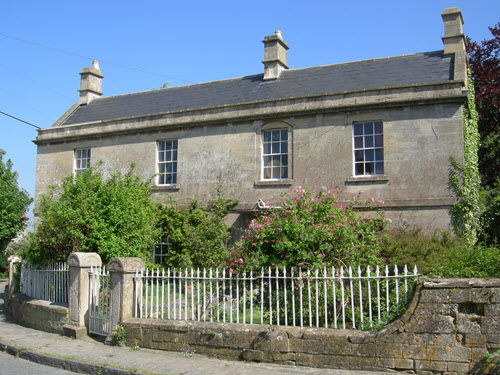
Bleak House is a Grade II listed building.5 According to the description on British Listed Buildings, it was built in 1824. I am not sure if Francis and Mary were the original owners or whether they moved in later but members of the family resided there up until 1945, as Ann Jane Taylor was living there with her younger brother Charles when she died in 19126, and her daughter Alice Nurse was living there when she died in 19457.
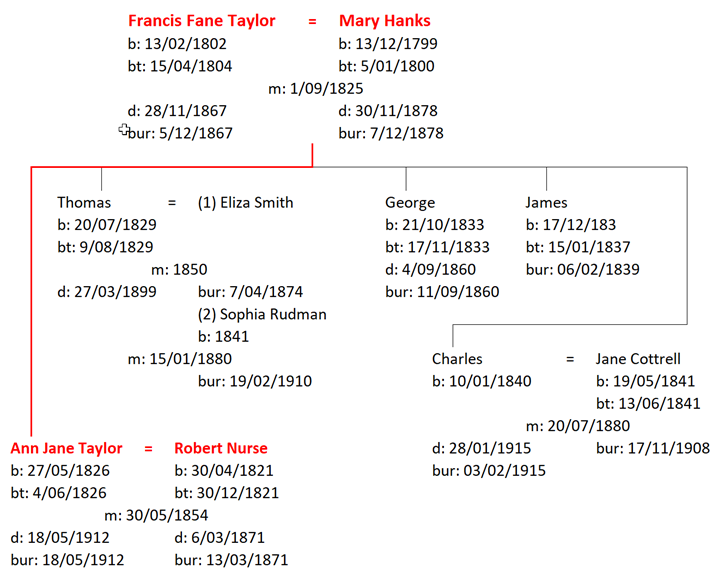
Francis and Mary had five children Ann Jane, the eldest and only daughter and four boys, Thomas, George, James and Charles. The oldest 4 children were baptised in St. Nicholas, Winsley, Ann Jane on 4th June 18268, Thomas on 9th August 18299, George on 17th November 183310 and James on 15th January 183711 but there is no record of Charles’ baptism. He is however mentioned in the 1841 Census.12
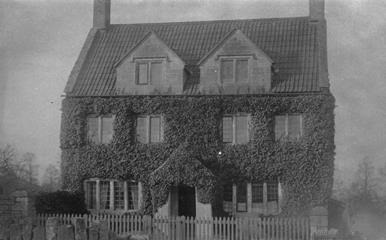
After some years Francis and Mary Taylor went to live at Bradford Leigh Farm, where they lived for many years13. Anne Jane, the only daughter, worked at home until she married. She was a clever needlewoman – she did very beautiful lace darning on both black and white.
Her great achievement was a long white shawl darned in patterns at both. She wore this shawl as her wedding veil and Janet Anne Nurse her great grand daughter (my aunt) wore it at her wedding in Hanham Parish Church on June 21 1947, it having been lent to her for the occasion by her cousins Harold and Bertha Nurse. (see F. E. Nurse (1953))
Ann Jane married Robert Nurse (see Section 3.2) at St Michael’s Two Mile Hill on 30th May 1854, and settled with her husband at the Rose and Crown, St George - a public house in a fairly good area on the eastern outskirts of Bristol.
Ann Jane’s aunt Eliza Williams (nee Hanks) was living in St George in the early 1850s, and I expect she met Robert when visiting her Aunt.
Francis Fane Taylor died in 1867 and was buried in Winsley on 5th December 186714 In his will he left Bradford Leigh Farm to his son Charles, who by then was operating the farm15. Mary Taylor lived for another 11 years, dying in 1878. She was buried at Winsley on the 7th December 187816
6.2 Henry Taylor of Bradford, (Born 1775)
4th Great Grandfather – FFFMFF
In many ways Henry Taylor is a pivotal player in my Family Tree research. In the previous section on the life of Francis Fane Taylor I mentioned that he was born in Farley, nr Salisbury and his father was Henry Taylor (see Section 6.1). I will also show in the next section on John Taylor - the landscape painter - that Henry Taylor was the youngest child of John and Rebecca Taylor (see Section 6.3).
But how do we know that this was the same Henry Taylor. After all Henry and Taylor are both common names today and were also common names in early 19th century England.
We will start with what I know about Henry’s life and later I will present the evidence that - in my opinion - conclusively shows that Henry Taylor the father of Francis Fane Taylor was the son of John Taylor the Landscape Painter.
Henry was born in 1775, being baptized on 7th October 1775 at St Swithen, Walcot in Bath 17, the son of John Taylor Esquire and Rebecca his wife. His parents were living in a house on the Circus at the time, and Walcot was fairly close.

Very little is known about Henry’s early life. While his two brothers, Richard and John were educated to be doctors, there is no record of Henry’s education. As the son of a gentleman, he presumably was educated, possibly privately.
Once he reached adulthood, he apparently moved quite frequently, eventually settling down in Bradford Leigh, just outside Bradford-upon-Avon in Wiltshire. This comes from my grandfather’s notes as he records the birthplaces of the children,(see W. R. Nurse 1937) which have been confirmed from the parish registers of the parishes concerned, as well as from census returns.
Henry married Jane Watts in Winterbourne Earls on 15th March 1798, by license18. In the license, Henry is described as a Yeoman, which was the next level below a Gentleman.
Richard, the eldest son was born in June 1798 and baptised at Winterbourne Gunner, near Salisbury, Wiltshire on 23rd July 179819. I believe that Richard died in infancy. There is no mention of him in any of the parishes where Henry and Jane lived. There is however a reference to a Charles Taylor, son of Henry and Jane Taylor, who died in 1799 and was buried on 30th October 1799 at Winterbourne Gunner, and there is no reference to a birth/baptism of a Charles Taylor before then, so I think that this was actually Richard and either he went by two names or the local Priest mis-wrote one of the entries20.
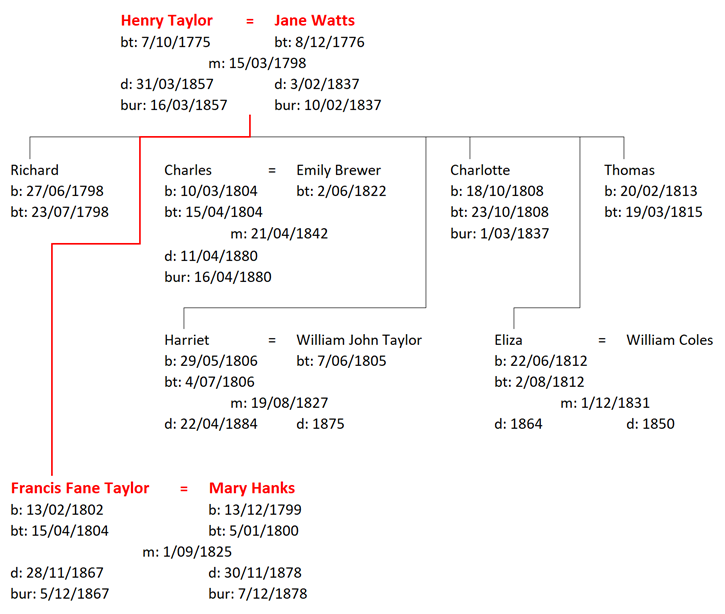
The next two children, Francis Fane and Charles were born at Farley, a neighbouring parish of Winterbourne Earls to the east of Salisbury, near the Hampshire border and they were both baptized there on 15th April 1804, when Francis was two21.
Harriet was born in Burleigh, Hampshire and Charlotte and Eliza were both born in Buttermere, Wiltshire, Charlotte being baptised on 23rd October 180822 and Eliza being baptised on 2nd August 181223
The last child, Thomas was born at Bearfield, near Bradford-upon-Avon and was baptized at St Nicholas, Winsley on 19th March 1815.24
According to the parish register of Winsley, Henry Taylor was a Farmer. In the late 1820s Henry and Jane and some of their children, moved to Alderholt in Dorset, where according to the Land Tax assessments for 1831 and 1832 Henry was the occupier of Harts Farm in Daggons, which was owned by the Marquis of Salisbury.

On 1st December 1831, Henry’s daughter Eliza married William Coles in Cranborne25. Cranborne was the neighbouring village to Alderholt which at that time did not seem to do Marriages.
In 1837 Henry’s wife Jane died. Jane was buried in Winterbourne Gunner, possibly in a Watts family plot. Their daughter Charlotte died soon after and her burial is the next entry in the Winterbourne Gunner burial register26.
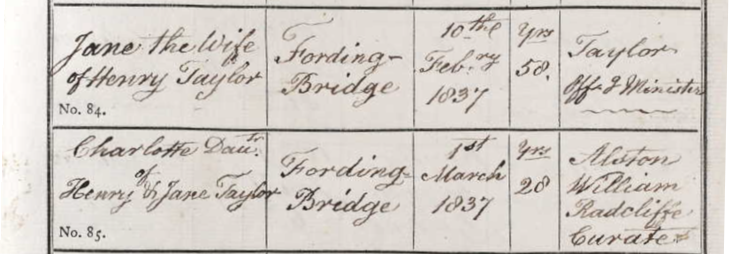
In the 1841 Census Henry is shown as still living at Harts Farm, with his son Charles, his daughter Eliza and 4 of her children27. The following year, on 21st April, his son Charles marries Emma Brewer at Cranborne28.
By 1846 Henry had moved to South Newton just outside of Salisbury, as his brother Richard leaves him a legacy in his will, which was written in 1846 (although Richard did not die until 1860)29. He probably moves there initially with his son Charles and Emma, as Charles’ daughter Charlotte who was born in 1846 was baptised in South Newton30.
In the 1851 Census, Henry is recorded as still living in South Newton31, although he is living on his own. His occupation is recorded as retired Farmer. He died 6 years later in 1857. I have a copy of his death certificate, where it says he died of “General debility of Age” on 11th March 1857 in South Newton. He was also buried in Winterburne Gunner on 16th March 185732, presumably with his wife Jane and daughter Charlotte.
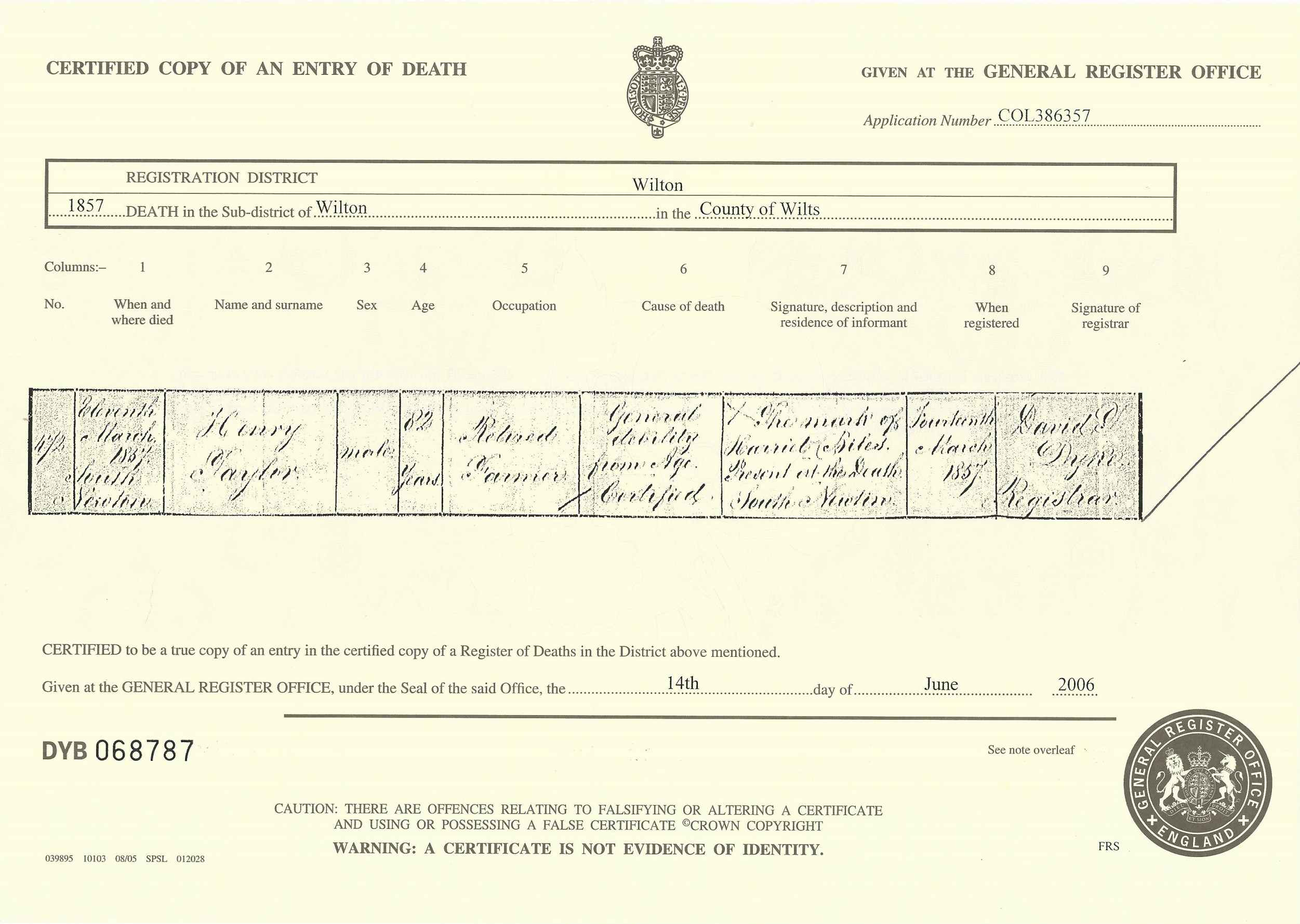
I have not been able to find a will for Henry who appears to have passed the farm nr Winsley onto his eldest surviving son Francis, before moving to Dorset to live near his other son Charles Taylor and his family.
So I will turn my attention now to the evidence that confirms that Henry Taylor was the son of John Taylor, landscape painter.
- Henry Taylor’s Death Certificate indicates his age as 82 which ties in with the baptism at St. Swithen, Walcot in 1775.
- Henry cites his birthplace as Bath in the 1851 census.
- While Henry names his first son Richard after his maternal grandfather (Richard Luther) he names his second son Francis Fane Taylor. The middle name is unusual, but it happens to be the name of his maternal cousin Francis Fane - the son of his mother’s sister Charlotte Luther and her husband Henry Fane of Worsley, Oxfordshire. According to Burke, although Francis Fane was MP for Dorchester, the county town of Dorset, he had a residence at Green Park Place in Bath, as did Richard Taylor, Henry’s brother. While it is unusual to name one’s son after one’s cousin, it would be even more unusual to name one’s son after a stranger, no matter how important that person might be.
- As mentioned above, Richard Taylor in his will mentions his brother Henry from South Newton, but also refers to paintings he inherited from his father John Taylor.
- And the most compelling piece of evidence is the will 33 of Henry’s nephew Richard Thomas Wilson Taylor, the son and heir of Henry’s older brother Richard Taylor. In this will, Richard refers to a painting by his grandfather John Taylor, which confirms that his father Richard was John Taylor’s second son Richard, and more importantly he mentions his dear cousin Francis Fane Taylor of Bradford Leigh, Bradford, as well his cousin Charles Taylor of Bemerton, Wiltshire (Francis’s younger brother).
It thus appears that Henry Taylor (Francis Fane Taylor’s father and Ann Jane Taylor’s grandfather) and my 4th great grandfather is the same Henry Taylor mentioned in the will of Rebecca Taylor (nee Luther) and baptized at St, Swithen, Walcot, and thus Ann Jane Taylor the wife of Robert Nurse (and my 2nd great grandmother) is the great-grand daughter of John Taylor, the Landscape Painter.
So Henry Taylor is pivotal as this opens the door into the landed gentry of England and the Gordon clan of Scotland.
6.3 John Taylor, Landscape Painter (Born 1735)
5th Great Grandfather – FFFMFFF
As I have described above Henry’s father was John Taylor, the Landscape Painter.
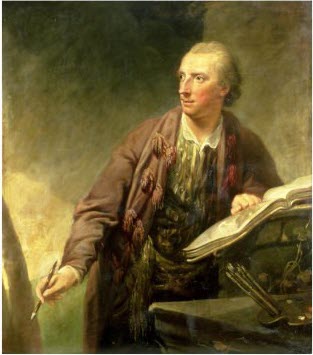
John was the only son of Abraham Taylor and Philadelphia Gordon - the daughter of Major General Patrick Gordon34, Deputy Governor and effective head of the Province of Pennsylvania from 1726 until his death in 1736. He was baptised 24th August 1735 at Christ Church, Philadeplphia.35
Although John Taylor was an artist of considerable repute during his lifetime36 - Benjamin Franklin called him the best Landscape Painter in England in a letter he wrote in 1783 complaining that all of America’s best painters went to Europe37 - very little of his early life can be learned today. We do know that he didn’t attend the Academy, of which his father was an eminent patron - at least he is not listed in the rolls. Instead, he was most likely tutored privately, probably in Philadelphia, but he may have been sent to school in England.
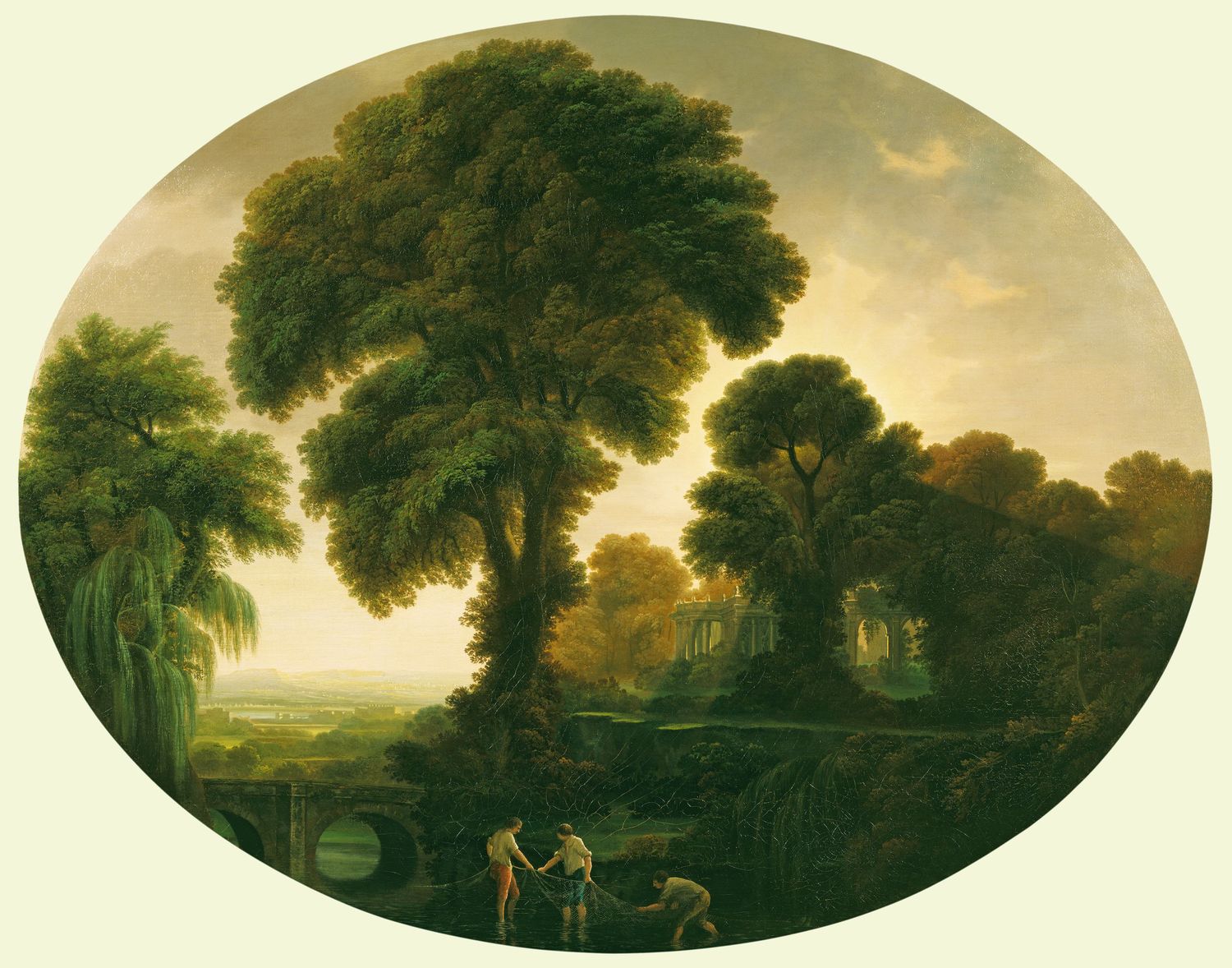
A number of his paintings are in the Royal Collection. For example Figure 6.12 is one of a pair of paintings that the artist gave to King George III and were hung in the Coffee Room at Kew Palace38. Figure 6.13 was part of a larger collection of paintings that the artists’s eldest son John Taylor gave to King George IV in 1822. It was said to have hung in Buckingham Palace in 184339.
At any rate, he was still living with his parents when they returned to England in 1762. Soon after arriving in England he married Rebecca Luther in Clifton on 4th June 1763. Whether the family settled in Bath immediately on their return from the colonies, John and his father Abraham purchased one of the new houses in the Circus (number 22) on Christmas Eve, 1766, and the family moved in soon thereafter.40 Thomas Gainsborough, another much more famous painter of that age, also lived in the Circus - at Number 17.
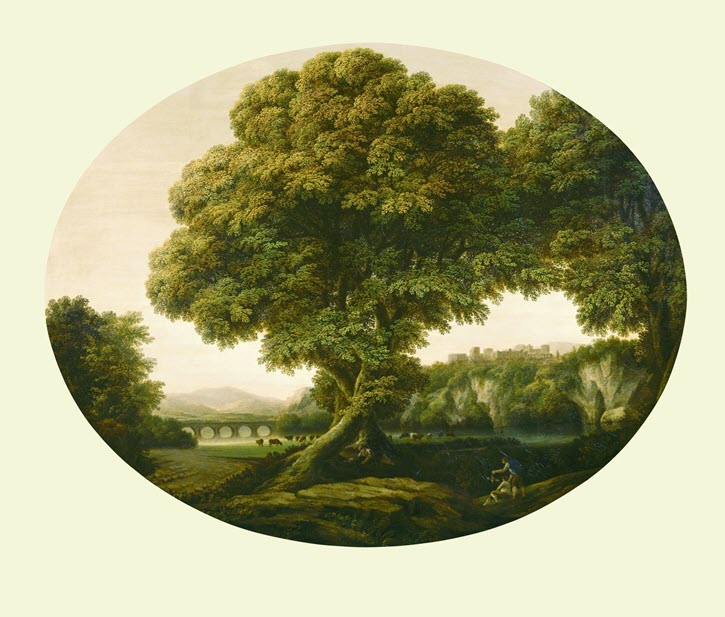
Rebecca Luther was the daughter of Richard Luther, esq. of Myles’s in Essex, and she was the last survivor of that family. Her sister Charlotte had married Henry Fane esq. of Wormsley, Essex in 1748, becoming his third wife, and after having two sons, John and Francis, died in 1758. When her brother John, who had represented the county of Essex in parliament, died she became, with her sister’s sons, co-heir of the Luther estates in Essex.
There is some confusion about John Taylor’s life during the decade of the 1760’s. This is no doubt due to the fact that there were at that time two other artists with the name John Taylor, a miniaturist and a John Taylor, actually “Old Taylor” who did Drawing at the Academy in St. Martin’s Lane.
However, he apparently lived at least part of his life in Bath and moved fairly freely in Bath’s high society. This is borne out by a number of published letters dating from that time.
Tobias Smollett, in his book Humphrey Clinker, writes through the letters from Bath of his creation, Squire Matthew Bramble:41
“In the course of coffeehouse conversation, I had often heard very extraordinary encomiums passed on the performances of Mr. T—-, a gentleman residing in this place, who paints landscapes for his amusement. As I have no great confidence in the taste and judgment of coffeehouse connoisseurs, and never received much pleasure from this type of art, those general praises made no impression at all on my curiosity; but at the request of a particular friend, I went yesterday to see the pieces, which had been so warmly commended – I must own I am no judge of painting, though very fond of pictures ………If I am not totally devoid of taste, however this gentleman of Bath is the best landscape-painter now living.”
These letters, while supposedly those of the fictitious Squire Matthew Bramble, are based on Smollett’s experiences in Bath during 1766. While John Taylor is identified by initial only, others were more explicit in identifying him. James Boswell, who was in Bath on 30th April 1776 noted in his journal:42
“Pump Room, gay. Breakfasted at Gould’s, called on Sharpe and the Sharplings. Then to John Taylor’s to see his pictures. Then to William Hoare’s.”
and Mrs. Thrale in a letter to Dr. Johnson of 28th April 1780 wrote:43
“This morning it was all connoisseurship; we went to see some pictures painted by the gentleman-artist, Mr. Taylor, of this place.”
The actor David Garrick also recorded his appreciation of John Taylor’s abilities in a poem entitled, “Upon seeing Mr. Taylor’s pictures of Bath and hearing a Connoisseur swear that ‘they were fairly painted for a gentleman’”:44
Tell me the meaning you who can,
Of “finely for a gentleman!”
Is genius, rarest gift of heaven,
To the hir’d artist only given?
Or. like the Catholic salvation,
Pal’d in for any class or station?
Is it bound ’prentice to the trade,
Which works, and as it works, is paid?
Is there no skill to build, invent,
Unless inspired by five per cent?
And shalt thou, Taylor, paint in vain,
Unless impell’d by hopes of gain?
Be wise, my friend, and take thy fee,
That Claud Loraine may yield to thee.
David Garrick, who first visited Bath in 1766 and returned occasionally in later years, appears to have been one of John Taylor’s closest friends, until the actor’s death on 20th January 177945.
The American Revolution of 1776 and the ensuing Revolutionary War would probably have caused a period of relative hardship for the Taylor family. The bulk of John Taylor’s estate, which he inherited from his father, was in investments in the American colonies. Exactly how much he was affected financially is difficult to assess, as the necessary documentation no longer exists. However, there are indications that he was concerned for his financial security.
In two letters to Benjamin Franklin in the early part of the decade, he expresses concern that land that he owned should not be forfeited to the newly independent government46,47. In one letter, dated 1st December 1782 he includes the statement: “be assur’d good Sir not a thought ever enter’d my heart which could give a shadow to suspect my warmest attachment and sincerest good wishes to that country”, the country he had left some twenty years earlier and to which, he saw it, various unavoidable circumstances had prevented his ever returning. He also put several of his paintings up for sale, no doubt in an effort to improve his financial position.
On 23rd November 1788 John Taylor, sold the house in the Circus to Mary Andre, Ann Andre and Louisa Andre and his family moved away from Bath to Grosvenor Place in the parish of St George Hanover Square, London, with the exception of his mother who stayed in Bath, where she died in 179348.
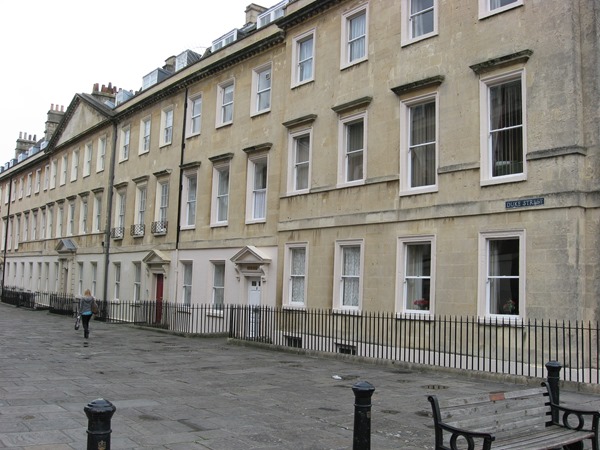
The family stayed in London until the turn of the century when they returned to Bath, where his name appears in the Bath directory. Their circumstances were not quite as good as when they previously lived in Bath, as they moved into 4 Duke Street, which while a decent townhouse, was nowhere near as “fancy” as the Circus.
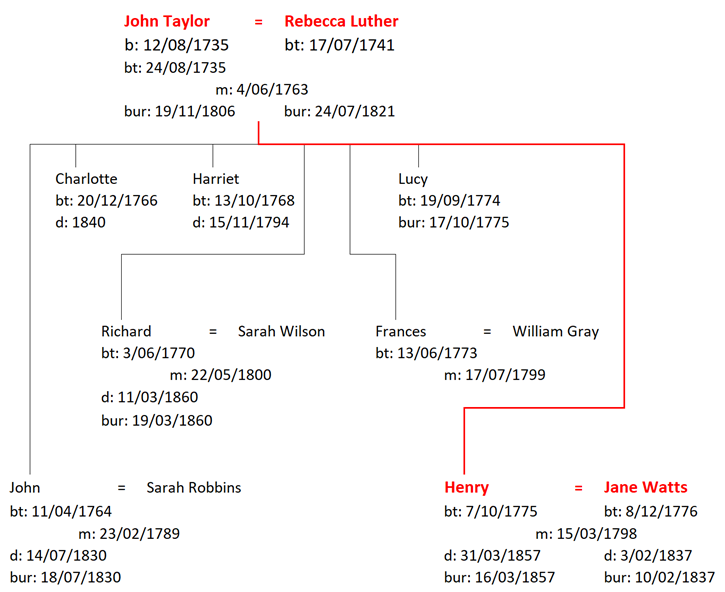
John and Rebecca had seven children, three sons – John, Richard and Henry – and four daughters Harriott, Charlotte, Frances and Lucy. All their children were baptised at St Swithen, Walcot, John the eldest on 11th April 176449, Charlotte on 20th December 176650, Harriett on 13th October 176851, Richard on 3rd June 177052, Frances (or Fanny) on 13th June 177353, Lucy on 19th Sep 177454 and Henry, the youngest, my direct ancestor, on 7th October 177555.
Two of the girls died quite young, Lucy as an infant of just over 12 months old and Harriet, at the age of 25. When Harriett died in 1794, she left a sum of money to each of her brothers and sisters still living naming them explicitly in her will.
Her father wrote “An Elegy On the Death of a … Daughter”. 20 copies were printed and bound, all of which were signed by her father. I have a reprint of the publication, which was signed by the author but also by John’s grandaughter - Anne Fane Stallard, the daughter of his oldest son John.56
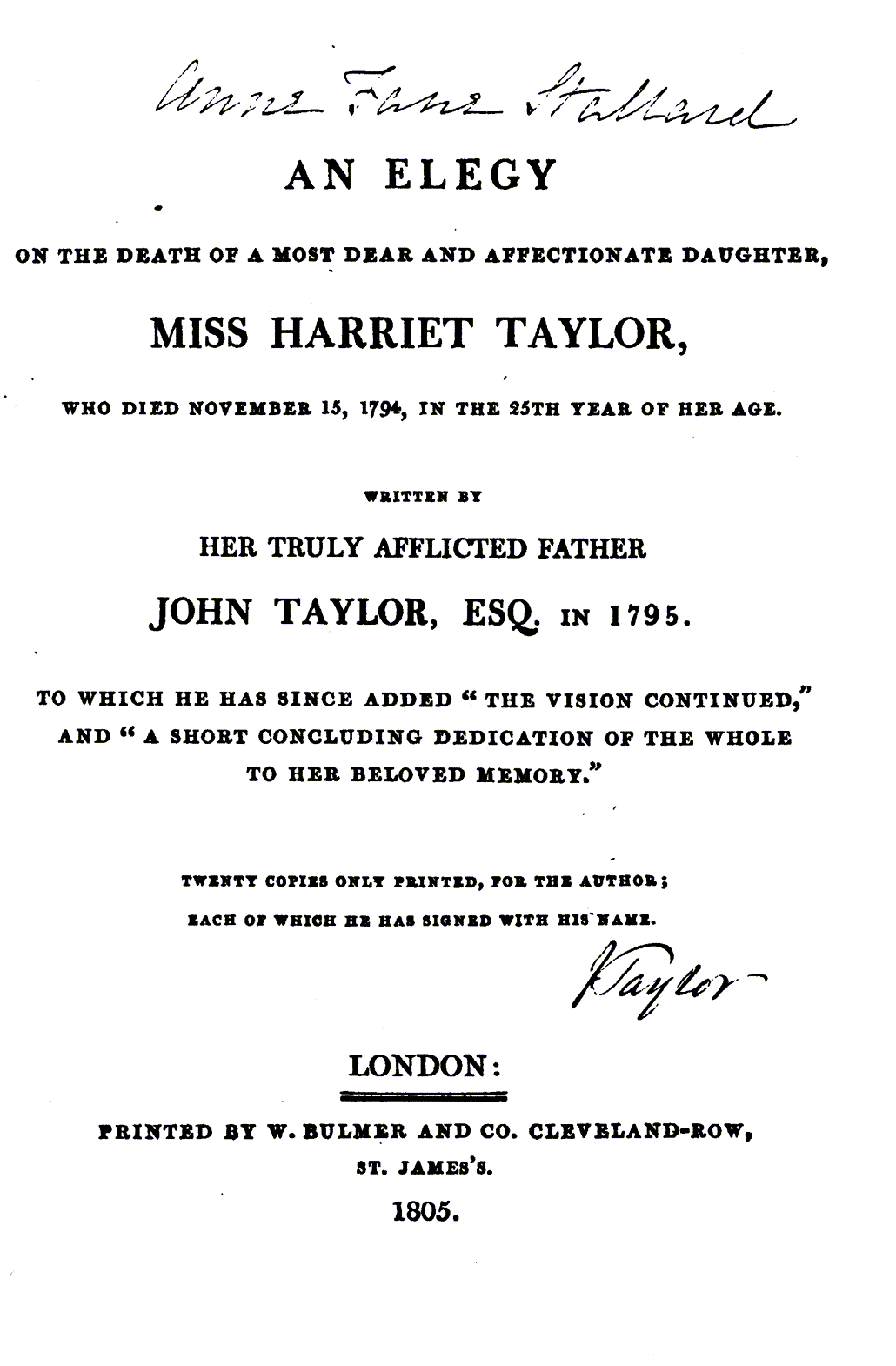
Apparently, two of John and Rebecca’s sons became physicians, although there are no records of their education. The eldest son, John practiced primarily in Dorset, while Richard practiced in Bath.57 John inherited from his maternal grandfather, Richard Luther, the estate of Vicar’s Hill, near Boldre in Hampshire, together with a half share in the Alderton Hall and Hinton Hall estates in Suffolk.58
John (the son) was also adopted by his maternal uncle, John Luther, but after a dispute with his uncle, John Luther having no children of his own bequeathed most of the Luther estates to the children of his other sister, Charlotte, i.e. Francis and John Fane.59
John Taylor died at his residence in Bath on 8th November, 1806, at the age of 72, and his death was recorded in a Bath paper of the day60.
“On Saturday died at his house in this city John Taylor, esq. Upon subjects of science and literature few men were better informed, but his excellence as a landscape painter will long be known to the world, from the beautiful engravings taken from some of his celebrated pictures. His house in this city, some years since, was resorted to by all persons distinguished for talent and genius.”
His wife Rebecca, died 15 years later in 1821, and both of them are buried at the parish of Newton St Loe just to the west of Bath.61,62
Both John63 and Rebecca64 left wills where they identify and give gifts of some kind to all of their surviving children.
6.4 Abraham Taylor of Philadelphia, Pennsylvania, Merchant Venturer (Born ~1700)
6th Great Grandfather – FFFMFFFF
John’s father, Abraham Taylor was a prosperous Philadelphia merchant and friend of Benjamin Franklin, before the American Revolution. He was my 6th great grandfather.
Burke’s Commoners states that Colonel Abraham Taylor “was the lineal descendent of George Taylor esq. of Derbyshire”. George Taylor was a magistrate for the county of Derbyshire and an East India merchant. However, no other information is given concerning the ancestry of Colonel Taylor65.
Abraham was born in 1702 or 1703 in England, and immigrated to Philadelphia, Pennsylvania from Bristol, entering into partnership in 1724 with John White as a “Merchant-Adventurer” in the North Atlantic trade.66
The business was very profitable but in 1741, White, wishing to return to England sold his interest to Taylor for £7000 sterling.67
After John White had returned to England and established himself first at Bristol and afterwards, when he retired, at Croydon, Surrey, Abram maintained communications with his erstwhile partner and friend. In these letters there are a couple of references to the Swifts, who were the in-laws of John White.
Oct 20, 1741 to John White at Bristol:
“Everything here is just as it used to be at this season of the year and the generality appear much the same as when you left us. But to one who has parted with an acquaintance, with whom he has had the strictest Intimacy, and the most sincere Friendship for so great a number of years, things appear with a different face. Pray remember us all in the kindest manner to Jack Swift.68”
Oct 30, 1741 to John White at Bristol:.. “Thank God we are at present, well, which I know will give you pleasure to hear, as I assure you, it would afford the greatest to me to have the same account from you and that your voyage has been agreeable to you.69”
September 29, 1743 to John White, Croydon, Surrey:
“Yesterday, I saw Richard Martin, who acquainted me that a few days before one of your nieces was married to the Brother of his son’s wife. He says it is a very good match, and I sincerely wish them and you joy of it; he promised to send you a Letter of it.70”
Aug 11, 1744 to John White, in London:
Dear Sir. My last was by Peter Reeve, wherein I inclosed you a bill of Lading for Pistoles and 8/8 to the value of about four hundred pounds, but to my great mortification I hear he is since taken by the French. This is not so great a loss but it might be bourne, had not a much greater immediately succeeded; two days after that bad news, the Tartar, a Privateer, a fine new ship in which I was interested 3/20ths overset in Our Bay, and is irrecoverably lost, together with eighty odd men who were all drowned, and upwards of a thousand pounds of mine along with her.
Mr Allen has just buried a fine child, which is a loss that sits very heavy upon him, and has prevented my knowing his thought about the proposal of selling your Land to him.
I have spoke to Mr. Peters about the Land in Right of Samuel Lee, and will take care to do what is necessary in it, of which I will write in my next, for at this time, I am too much mortified to say any thing more, except that I am Messrs Swifts and Dear Sir, Your most affectionate humble servant, Abram Taylor71.
In 1737 or 1738 John Swift had sent his children to Philadelphia and had then returned leaving them in the care of their maternal uncle, John White. When John White returned to England he left his nephews and nieces in the care of his partner and friend.
Abraham Taylor moved freely in the colony’s high society, aided no doubt by his wealth, but also by his marriage in 1733 to Philadelphia Gordon, daughter of Major Patrick Gordon (see Section 9.1) 72, Deputy Governor and effective head of the Province of Pennsylvania from 1726 until his death in 1736.
Burke (1838) states that Philadelphia Gordon was the only surviving child of Governor Patrick Gordon, but Keith (1917) mentions that in 1726, when Patrick Gordon arrived to take up the governorship, he brought “five of at least six children then living” with him to Philadelphia.
I have a copy of Governor Gordon’s Will and Administration, in which 6 Gordons are mentioned by name, Captain Charles Gordon, Archibald Gordon, Elizabeth Gordon, Henrietta Gordon, the wife of Robert Charles, Agatha Harriet Gordon and Philadelphia Gordon, wife of Abraham Taylor. It is not expressly stated that they are all children although both Robert Charles and Abraham Taylor are referred to as “my son”.
During his life, Abraham Taylor was to play a considerable role in the life of the colony and in particular the city of Philadelphia. At the time of the dissolution of his partnership with John White he was a member of the City Corporation, and on December 14, 1741, he was appointed by the then Governor, Honourable George Thomas, as a member of the Governor’s Council,73 although he apparently looked forward to an early departure from the colony, complaining that its climate was ill suited to his constitution, and the place afforded “little of what is either entertaining or amusing”74.
In the latter half of 1744, the position of collector of the Customs became vacant by the death of Mr. Alexander and having a deputation from Grosvenor Bedford Esq. (the titular Collector of Customs) he assumed the duties, “rather than a friend should suffer by the office being depreciated and undervalued since the commencement of the French War.” He held the position for most of the next 15 years.75
In 1745 he was elected Mayor of Philadelphia, although he declined to serve his term, and was subsequently fined.76 He was one of the most active Councilors when, under Palmer’s presidency, the Council acted as Governor of the Province.
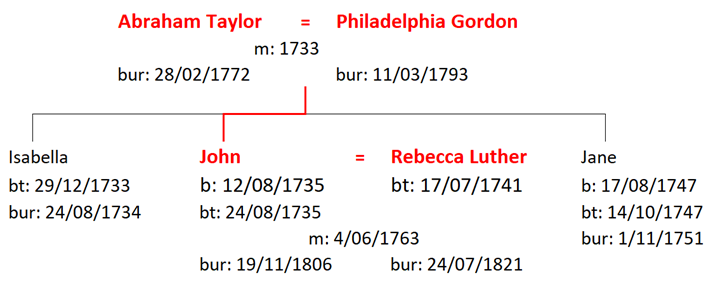
Through these activities he formed a strong and lasting relationship with Benjamin Franklin. He was made colonel of the regiment of Associates for Defense that Franklin formed during the latter part of 1747 for the protection of Philadelphia during the Seven Years War,77 he was a member of the subscription Library that Franklin founded with others in 173178 and he was one of the original trustees of the Academy, now the University of Pennsylvania, which was established by Franklin and some friends in 1750-1751.79
Abraham and Philadelphia Taylor had at least three children, one son and two daughters, as their baptisms are documented in the baptismal records of Christ Church, Philadelphia.80
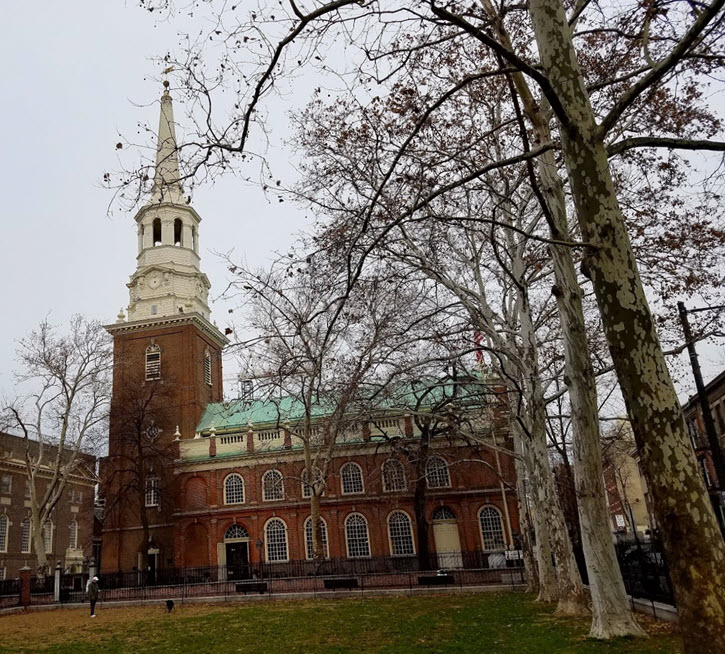
Both daughters died during childhood, Isabella before her first birthday and Jane at the age of four, their burials also being recorded in the records of Christ Church. However, their son John survived to become quite a well-known Landscape Painter.81
In the early 1750’s Abraham Taylor was in dispute with the Proprietaries (the descendants of William Penn, the founder of Pennsylvania) over some land, which he had obtained, when he had dissolved his partnership with John White.82
White had purchased 2147 acres from the Crispin family. William Crispin had been one of the original Commissioners appointed by William Penn to represent him when the province of Pennsylvania was founded, and upon his death Penn gave 3000 acres to his seven children. In 1733, a warrant to White authorized him to locate his land where he found a desirable place.
White had surveys made and patents were issued to him for 300 acres adjoining Richard Penn’s Manor. Later, for some unexplained reason, the Proprietaries granted the 300-acre tract to Peter Klop, Conrad Sharp and Henry Sellars. White was on good terms with Thomas Penn and made an amicable arrangement with him that White should have 300 acres of as good land in some other place.
When White and Taylor dissolved their partnership in 1741, the patent for this land fell to Abraham Taylor, as did a further 478 acres that White had purchased from the Crispin family. Taylor requested that the 300 acres as well as the 478 acres be located on a strip of land cut off from the manor of Andolhea, giving as his reason, that Conrad Weiser and Surveyor-General Parsons had assured him that he could get a good price for it. Thomas Penn refused to allow him to have more than the original 300 acres at that location, and Abraham Taylor refused to take any of it if he could not have it all there. This controversy went on for a number of years.
Taylor went to London in 1750, with the intent of selling his right to the land. While there he presented an elaborate argument to show that the southern boundary of Pennsylvania should not be south of Latitude 40º, and that Virginia and Maryland had a right to all the land below this line. He threatened to give this information to the buyer.
The Proprietaries declared this a dishonest attempt to force them to accede to Abraham’s wishes and wrote to Lieutenant-Governor Hamilton, ordering him to strike Taylor’s name from the list of the Council and to be deprived of all powers in the provincial government.
The Proprietaries had also discovered that Taylor had signed an agreement with Lord Baltimore to the effect that if the information to be furnished by Taylor was sufficient to establish Maryland’s territorial claims, he was to receive one-seventh of all the land thus recovered from Pennsylvania or equivalent compensation. Although the Proprietaries’ letter was to be forwarded to the City Corporation, Taylor continued as one of its members from his return to Philadelphia until his final departure from the Province.
On 1st July 1762, Abraham Taylor was guest of honour at a dinner arranged by more than a hundred of the most prominent residents of Philadelphia.83 Soon afterward he returned “home” to England, like many others who had prospered in the North Atlantic trade. By this time, he was quite a wealthy man, and he settled down in Bath to live out his remaining years as the gentleman of means, he had become. The family occupied a townhouse in the Circus, which at that time was still under construction.
In 1765, the long drawn out controversy over Taylor’s 778 acres was finally settled. That year Penn agreed that Taylor should have the entire 778 acres where he had first requested it, but now Taylor refused to accept it and demanded money with interest. Two years more went by and the Proprietary, weary of the struggle finally capitulated and agreed to pay Taylor the sum of £788 4sh., for the 778 acres, and the long dispute was over.
Within 10 years of the family’s return to England Abraham Taylor was dead.84 He was buried at St Swithen, Walcot on 28th February 177285 His wife Philadelphia lived for another 21 years, dying in March 1793. She was also buried at St Swithen, Walcot86.
His estate with the exception of a small annuity for his wife, passed to his son.87,88 Although, he had suffered some financial setbacks after his return to England, his estates were still considerable.
Thus, his son John Taylor was a man of sufficient substance that he was able to continue his life as the amateur gentlemen artist, without any financial worries.